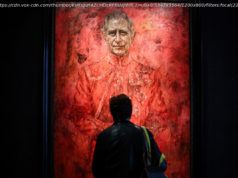From the pages of The Times.
Happy Thanksgiving. This year’s holiday is more normal than last year’s, before the Covid vaccines had arrived. But it still is unusual for many families, involving some combination of antigen tests, outdoor meals (where the weather allows) and underlying anxiety. With that mind, my colleagues and I put together a brief history of Thanksgiving celebrations since the 1850s, focusing on unusual years like this one. Farther down in today’s newsletter, you’ll also find last-minute cooking tips, suggestions for holiday television and more. However you spend the day, we hope it’s a good one. We want to say thanks specifically to two groups of people: first, to everybody who’s working today (including our colleagues putting out The Times and delivering the print edition); and, second, to all of you — the readers of The Morning. We are grateful that you make time in your day for this newsletter. The first appearance of the word “thanksgiving” in The Times digital archives — which go back to 1851 — did not refer to the holiday. It instead was a reference on Oct.4,1851, to “an appropriate prayer and thanksgiving” from a reverend at the opening of the Queens County’s annual agricultural exhibition. “Thursday was quite a jubilee in the pleasant village of Jamaica, Long Island,” an unnamed reporter for The New York Daily Times wrote. “The ruddy, manly appearance of the farmers, and the freshness, delicacy, and real natural loveliness of their wives and daughters, (for which the county is justly renowned,) were sights to cheer and amaze the citizen, and many were there to witness and enjoy them.” The first mention of the holiday occurred less than a week later, in a brief news item reporting that the governor of Massachusetts had declared Thursday, Nov.27,1851, as “a day of public thanksgiving and praise.” There was no national Thanksgiving holiday at the time. As other states announced when they would also be observing the holiday that year, The Times printed an infographic — of questionable value — on Oct.31,1851: The origin story of Thanksgiving that’s often told in school — of a friendly meal between pilgrims and Native Americans — is inaccurate. (As far back as 1974, The Times ran an article describing the holiday as a “national day of mourning” for many Native people.) The real origin of the national holiday dates to Abraham Lincoln. On Oct.3,1863, he called for the country, “in the midst of a civil war of unequaled magnitude and severity,” to set aside the last Thursday in November as “a day of Thanksgiving.” The Times published his Thanksgiving proclamation on the front page, and several times subsequently. While reciting the country’s many blessings — a productive economy, bountiful harvests and a growing economy — Lincoln also recommended that Americans give thanks “with humble penitence for our national perverseness and disobedience.” Lincoln’s proclamation was in part a response to Sarah Josepha Hale, an editor who had spent decades campaigning for a national day of gratitude. Like this year’s version, Thanksgiving in 1918 occurred in the midst of a global pandemic. But the atmosphere was surprisingly joyous.






